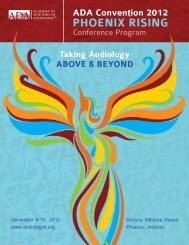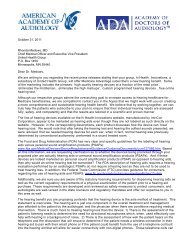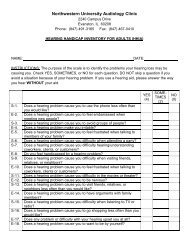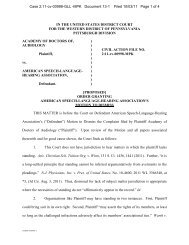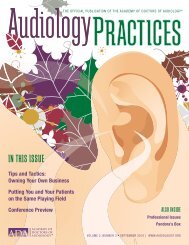IN THIS ISSUE - Academy of Dispensing Audiologists
IN THIS ISSUE - Academy of Dispensing Audiologists
IN THIS ISSUE - Academy of Dispensing Audiologists
You also want an ePaper? Increase the reach of your titles
YUMPU automatically turns print PDFs into web optimized ePapers that Google loves.
DIAGNOSIS & TREATMENT<br />
More than ten years have passed since hearing aids<br />
with directionality experienced a revival in the industry.<br />
Today, most hearing aids dispensed have directionality and enhancements to this<br />
basic feature have made the only proven way to help with hearing in noise when<br />
using hearing aids even more effective for listeners. This article will focus on<br />
some new developments that have solved some problems that remained with this<br />
effective feature.<br />
Although directionality in hearing aids is a proven feature improving the signalto-noise<br />
ratio for patients in noisy environments (Killion et al., 1998; Valente et<br />
al., 1995; and Walden et al., 2000), many recent improvements have made this feature<br />
even more useful to hearing aid users. Directionality has been available in<br />
hearing aids since the early 1970s, but the late 1990s marked a resurgence <strong>of</strong> this<br />
feature in hearing aids. Directionality <strong>of</strong> the 1990s was improved over the 1970s<br />
with increased directivity indexes (better performance) and the ability to switch<br />
the hearing instrument from omni directional to directional settings either manually<br />
or automatically. Recent developments in directional-microphone hearing<br />
aids that have tried to further improve user benefit by solving some lingering problems<br />
associated with the feature. This article will detail these developments including<br />
the emergence <strong>of</strong> wireless technology which provides the opportunity for even<br />
greater help when listening in noise.<br />
Split-Band Directionality<br />
problem solved: the sound quality in the directional setting is<br />
either noisy or tinny.<br />
The benefit <strong>of</strong> using directionality in noisy environments has been demonstrated<br />
in both the real-world and laboratory, listening in the directional setting has <strong>of</strong>ten<br />
come at the cost <strong>of</strong> sound quality. Inherent in the design <strong>of</strong> directional hearing<br />
aids is a low-frequency roll-<strong>of</strong>f which occurs because low-frequency sounds have<br />
similar phase relationships between the front and rear microphones. To accommodate<br />
for the decrease in audibility caused by this roll-<strong>of</strong>f in the directional setting, a<br />
boost in low-frequency amplification is usually applied (this is called equalization).<br />
Equalization causes the internal noise floor <strong>of</strong> the hearing aid to increase and ultimately<br />
can detract from the benefit <strong>of</strong> the directional setting (Ricketts and Henry,<br />
2002). The result <strong>of</strong> not compensating for this low frequency roll-<strong>of</strong>f though has the<br />
undesired effect <strong>of</strong> making the hearing aid sound quality tinny in the directional<br />
setting. Thus, traditional designs have the trade <strong>of</strong>f <strong>of</strong> either being too noisy or too<br />
tinny rather than sounding natural.<br />
A solution for this problem is to process the sound in the hearing aid the same<br />
way it is processed by a normal-hearing listener. This processing, called split-band<br />
directionality, approximates the unaided ear’s natural directional characteristics.<br />
Figure 1 illustrates how the open ear and split band directionality are similar. The<br />
KEMAR response for four frequencies is shown on the left in the polar plot. For the<br />
two lower frequencies the response is essentially omnidirectional while the higher<br />
frequencies are directional to the front. The panel on the right presents the same<br />
AUDIOLOGY PRACTICES n VOL. 3, NO.2 15



